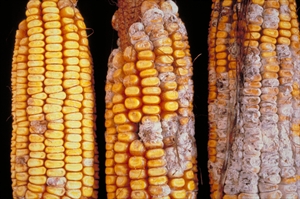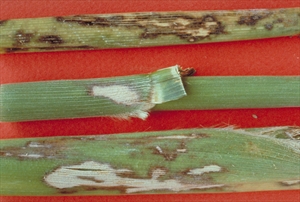Kernel rot, bakanae disease of rice
Pacific Pests, Pathogens, Weeds & Pesticides - Online edition
Pacific Pests, Pathogens, Weeds & Pesticides
Maize Fusarium kernel rot (224)
Gibberella fujikuroi; previously Gibberella moniliforme. Known more commonly by the asexual state, Fusarium moniliforme. There are several strains of the fungus, and many names. Previously Gibberella fujikuroi and Gibberella fujikuroi var. subglutinans were considered distinct, but in the CABI database they are recorded under one name: Gibberella fujikuroi.
Asia, Africa, North, South and Central America, the Caribbean, Europe, Oceania. It is recorded Australia, American Samoa, Cook Islands, Fiji, Guam, New Caledonia, New Zealand, Papua New Guinea, Samoa, Solomon Islands, and Vanuatu.
Maize, banana, pineapple, rice, sorghum, and sugarcane. Many plants in many families are hosts, although those of the Poaceae, the grass family, has crops of most economic importance.
The fungus develops in storage on the cobs that have not been dried properly. Grey or pinkish-white fungal growth covers the grains, sometimes with individual grains showing a reddish-brown colour (Photos 1&2). Infections are also seen in the field: irregular white spots with dark borders develop on the sheaths (Photo 3), and kernel rots develop on cobs when harvests are delayed. Rots seldom cover the whole cob.
The fungus produces a toxin that affects horses and humans.
Spread is by airborne spores on the wind. It is also spread on and in seed. Seed becomes infected in three ways: (i) from the seed into the stalks and then kernels; (ii) direct penetration of the stalks and into the kernels; and (iii) infection through the 'silks', the long stigmas of the maize flowers through which the pollen travels. Silk infections are the most important way seed becomes infected.
Kernel infections are favoured by temperatures above 16°C, and rainfall and relative humidity above 70%.
There are different strains that do not mate. For instance, Gibberellia fujikuroi from rice, maize and sugarcane do not mate with each other, and belong to one mating group, and those from rice another. There are also different mating groups in Fusarium moniliforme; one group includes those from maize, another from sorghum.
Gibberelea fujikoroi (Fusarium moniliforme) is an important pathogen of many plants. On rice, it causes bakanae, a disease where tillers grow much taller than usual, and there is a complete lack of grain. In Fiji, it is reported to be the most serious seed and seedborne disease of dryland rice. In other hosts it is associated with seedling blight, 'foot' rot (i.e., base of the stem), stunting, and enlargement of tissues, and seed rot.
In New Caledonia, Fusarium moniliforme caused a disease of horses called 'leucoencephalomalacia'. In 1981, 45 horses showed symptoms and five died after eating contaminated maize. The animals showed loss of coordination, tremors, periods of excitement and drowsiness, and damage to their livers and nervous systems, amongst other symptoms.
Look for red-brown kernels scattered over the ear, and pinkish-white cottony (powdery) fungal growth on cobs that have not been dried properly after harvest and before storage.
CULTURAL CONTROL
Before planting:
- Choose varieties that are known to have tolerance to kernel rot.
- Ensure that seed is treated with fungicide (see Chemical Control).
During growth:
- Make sure that the plants have adequate nutrients, and irrigate plants (if possible) during dry times.
- Control earworms and corn borers; insect damage increases kernel rots caused by fungi. .
- Harvest as soon as the ears are mature, and dry them properly before storage. Moisture contents below 18% for cobs, and 13-15% for seed are necessary.
After harvest:
- Clean the ears, seed, and storage bins before use, removing any dirt, dust or grain left in the bins from their last use.
- Protect grain from insects.
RESISTANT VARIETIES
Probably, none of the hybrid maize varieties are totally resistant to kernel rot, but some will show tolerance, and this is the best method of managing the disease.
CHEMICAL CONTROL
If seed treatment is required, use a combination of carboxin and thiram that is sold as a commercial product (in Australia).
____________________
When using a pesticide, always wear protective clothing and follow the instructions on the product label, such as dosage, timing of application, and pre-harvest interval. Recommendations will vary with the crop and system of cultivation. Expert advice on the most appropriate pesticide to use should always be sought from local agricultural authorities.
AUTHOR Grahame Jackson
Information from CABI (2014) Gibberella fujikuroi (bakanae disease of rice). Crop Protection Compendium. (https://www.cabi.org/cpc/datasheet/25158/). Photos 1,2&3 Kohler F, et al. (1997) Diseases of cultivated crops in Pacific Island countries. South Pacific Commission. Pirie Printers Pty Limited, Canberra, Australia.
Produced with support from the Australian Centre for International Agricultural Research under project PC/2010/090: Strengthening integrated crop management research in the Pacific Islands in support of sustainable intensification of high-value crop production, implemented by the University of Queensland and the Secretariat of the Pacific Community.






